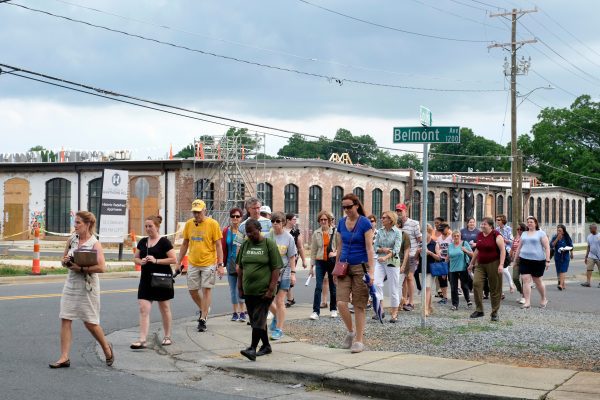Food, history and connections: Charlotte City Walks returns for 2019

In 2012, local historian Tom Hanchett wanted to explore his fascination with Central Avenue.
He led a community walk down the busy thoroughfare, bustling with new businesses, older neighborhoods and a growing immigrant community.
“I was beginning to see Central Ave as an urban place, which at that point in time sounded like a contradiction in terms, because it was built as suburbia,” said Hanchett. “There are people walking. There are older buildings…Not museum piece buildings. Not wonderfully restored buildings. But ordinary buildings where new ideas can happen, where you can start a business.”
It was the beginning of Charlotte City Walks. From that one stroll, the program has grown to almost 40 separate walks this year – Hanchett is leading a half-dozen – with walks designed to appeal to everyone from foodies to history buffs to art enthusiasts.
The free program is organized by the UNC Charlotte Urban Institute, with assistance from the Foundation for the Carolinas and an array of local partners. Angelique Gaines, of the Urban Institute, said the walks offer both longtime and new Charlotte residents the chance to connect and discover parts of the city they haven’t visited before.
“I think City Walks are important for our city because it allows people to learn more about their community and connect across differences,” said Gaines. “We’re in our own bubbles sometimes, and we have our own networks.”
Participants will get an up-close look at deeply rooted neighborhoods such as Belmont, a former mill village undergoing radical redevelopment, explore murals in NoDa or the public art along the Blue Line light rail, or taste some of the city’s thriving food scene.
Charlotte City Walks is a part of the annual tradition known in many cities as Jane’s Walks. The free tours, led by local citizens, were inspired by urbanist Jane Jacobs, whose classic “Death and Life of Great American Cities” helped reshape the way people thought about urbanism.
Hanchett said the annual walks enable people to learn more deeply about their city, and connect with people they likely wouldn’t otherwise encounter.
“It’s a social thing. You’ll meet interesting people,” he said. “I think you’ll begin to see things differently. You’ll have a different appreciation for this city.”
Hanchett also hopes that Charlotte City Walks help counter the idea that Charlotte doesn’t have the rich history or character of older cities that bloomed in the pre-automobile age.
“We still tend to kind of reflexively look down our noses at areas that don’t look the way we think of as historic,” said Hanchett.
Of Charlotte, he said: “It does not look like Boston. It does not look like Chicago. It looks a lot like Charlotte.”
You can see a full schedule of the walks, which start April 28 and run through May, online at www.citywalksclt.org. You can register to attend on that website. Space is limited, and some walks are already filling up.
Some of the highlights this year include:
- Munching tours: These are ever-popular tours of Charlotte’s culinary scene, with an Ethiopian coffee ceremony, Vietnamese food, Syrian pastries and more lined up this year. Five are scheduled this year, including the first two English/Spanish bilingual tours, and walkers will explore areas such as East Charlotte, South Boulevard and Central Avenue.
- Experiential walks: Ever wondered what it’s really like to be homeless in Charlotte? “Walk in my Shoes,” by the Urban Ministry Center, will give you a chance to experience the search for food and services. Volunteers on a separate walk will also get to explore and clean up Tom Hunter Park in a service project.
- University City: What’s next for this fast-changing part of Charlotte? A walk through this area will explore the history and development plans for the area around UNC Charlotte. And another tour will explore the university’s botanical gardens, the school’s “green heart.”
- Get a taste of Charlotte history: Think Charlotte doesn’t have a rich and varied history? Think again. Explore uptown when it was Charlotte-Towne at the time of the American Revolution, check out Elmwood-Pinewood or Charlotte Hebrew Cemetery, or learn about the history of neighborhoods like McCrorey Heights and Plaza Midwood.
- Public art: Check out the murals and other art along the Blue Line, see the murals of NoDa or get the details on how a Charlotte artist is transforming drab utility boxes in South End into works of art on some of the art-focused walks.
Ely Portillo